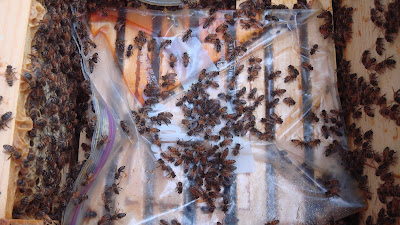
Today I opened the two hives to check on the Ziploc bags of honey I left on them about 10 days ago. In Mellona, most of the honey had been eaten and I didn't see many small hive beetles - I believe the cooler nights are taking their toll on the growth of SHB. I pulled the bag out and hung it over the deck rail. See how the bees gather around the slit (on the top of the rail). The rest of the bees clustered over the honey that gravity pulled to the lower corner.
I put a bag of 2:1 sugar syrup in Mellona and cut a slit in it. I also returned the remains of the bag of honey, pulling the corners up against the hive body to encourage gravity to draw the honey toward the slit.
In Bermuda, the situation was about the same. Most of the honey was gone from the bag. In this hive I discovered small hive beetles clustered in the zipped opening of the bag.

 See them in the last picture
See them in the last picture ? It's not clearly focused - the camera focused on the bees behind the bag on the frame of honey. I squashed the beetles by pinching closed the zipped area - some escaped by flying away.
? It's not clearly focused - the camera focused on the bees behind the bag on the frame of honey. I squashed the beetles by pinching closed the zipped area - some escaped by flying away.In this hive I returned the honey bag, turned upside down with the split against the frames, again raising the corners of the bag to encourage the help of gravity. I added a bag of 2:1 sugar syrup beside the original bag and using a sharp knife, cut a slit in the bag.
The whole time I fooled around with this task, I kept thinking of Sue Hubbell's book that I am reading, A Book of Bees, in which she gently points out that when we approach the hive with the hive tool, every time we free a part of the hive - like lifting up the inner cover - we are destroying the hard work of propolizing the hive to keep the cold air out.
I know I'm in Atlanta where it's 70 something today and almost every day of at least 8 months of the year, but I feel bad that after I do my beekeeping tasks, the bees have to redo work that they didn't destroy - I did.


i have seen the baggie method of feeding a lot lately. Would you tell me how you learned of this and where I could go to learn the particulars of this method?
ReplyDeleteThanks for your blog. I always learn something.
I learned about it on Beemaster as well as from Jennifer Berry when she spoke to our bee club. You take a good quality (ie, Ziploc - not an imitator) ziploc bag and fill it half way with 2:1 sugar syrup. You lay it on top of the frames and with a sharp knife, slice a 3 - 4 inch cut in the top of the bag - careful not to cut through the other side. The air comes out of the bag through the slit and the syrup oozes onto the top of the bag - the bees can feed there and they will not drown as in some other feeders. When I removed the two bags today there were absolutely no dead bees in the bag.
ReplyDeleteIs very beautiful method!! i has not left never without food the girls my!! bravo has one very beautiful blog!!!
ReplyDeleteI've used the baggie method with the slit(s) and lost a few bees. So, instead of slits, I tried poking little holes in the center of the bag with a safety pin. Results: no dead bees. When the bag is almost empty, except for the corners: poke holes in the corners.
ReplyDelete